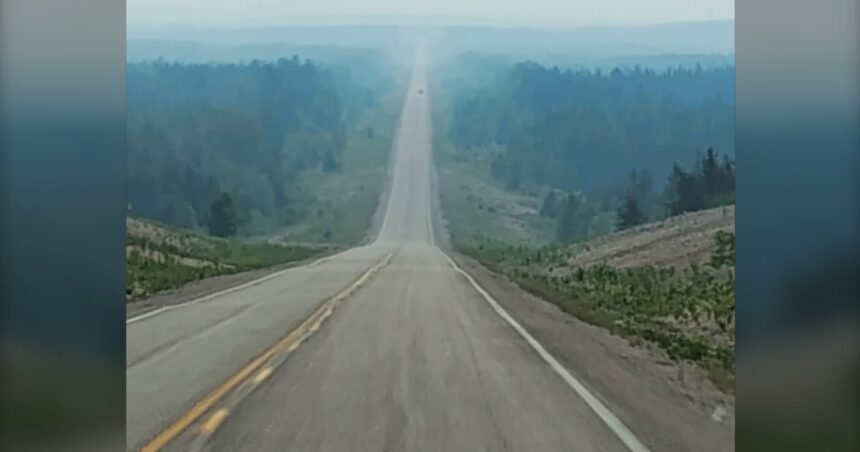The billowing smoke swallowed the northern horizon before anyone in Pukatawagan First Nation had time to prepare. Martha Bighetty, a community elder I spoke with yesterday, described watching the sky turn from blue to orange to an ominous gray in less than 48 hours.
“We’ve seen fires before, but the speed of this one…” she trailed off, pointing toward her grandson’s inhaler on the kitchen table. “The little ones and our elders, they feel it first in their lungs.”
As wildfire season intensifies across Northern Manitoba, communities are facing critical health challenges beyond the immediate threat of flames. Provincial health officials confirmed yesterday that over 280 residents with respiratory conditions have been evacuated from four northern communities, with Pukatawagan First Nation and Mathias Colomb Cree Nation facing the most severe impacts.
The Canadian Interagency Forest Fire Centre reports that 31 active wildfires are currently burning across northern Manitoba, with 12 classified as out of control. This represents a 40 percent increase from this time last year, according to Environment Canada data.
Dr. Michael Routledge, Manitoba’s Medical Officer of Health for the Northern Region, told me these evacuations are preventative but necessary. “We’re seeing an alarming spike in emergency room visits for asthma exacerbations and COPD complications. The particulate matter in wildfire smoke is extremely fine and penetrates deep into lung tissue.”
The Canadian Red Cross has established temporary reception centres in Thompson and The Pas, though capacity concerns are mounting. Jordan Charron, emergency response coordinator with the Red Cross, mentioned they’re already at 85 percent capacity. “We’re preparing contingency plans to possibly utilize facilities in Brandon if the situation worsens,” he explained during our phone conversation Tuesday morning.
On the ground, the situation reveals gaps in northern emergency health infrastructure that provincial officials have acknowledged but struggled to address. During last year’s budget deliberations, the Manitoba Legislature approved $4.2 million for northern emergency medical services, but community leaders say implementation has been slow.
Chief Shirley Ducharme of O-Pipon-Na-Piwin Cree Nation expressed frustration with the response timeline. “When Thompson or Winnipeg faces a health crisis, resources materialize overnight. When it’s our communities, we’re told to be patient with the process,” she said while coordinating shelter arrangements for arriving evacuees.
The smoke isn’t just affecting those with pre-existing conditions. Healthy residents report headaches, irritated eyes, and unusual fatigue. Environment Canada’s Air Quality Health Index has registered readings of 9+ (high risk) across the region for four consecutive days.
This situation highlights the complex relationship between climate change, public health, and northern Indigenous communities. The data tells an alarming story – Manitoba’s wildfire season has lengthened by approximately three weeks over the past two decades, according to research from the Prairie Climate Centre at the University of Winnipeg.
Provincial officials maintain they’re responding appropriately. “We’ve deployed additional air purifiers to community centres and schools that remain open, and we’ve increased medical transport capacity by 35 percent,” said Minister of Indigenous Reconciliation and Northern Relations Eileen Clarke in yesterday’s press briefing.
However, residents like Sam Bigsky from Leaf Rapids question whether these measures are sufficient. I met Sam at the Thompson reception centre where his 72-year-old mother had just arrived by medical transport. “She’s been on oxygen for years. We knew this fire season would be bad, but nobody called to check if we needed evacuation until she couldn’t breathe properly,” he told me, fatigue evident in his voice.
Meteorologists predict little relief in the coming week. Environment Canada forecasts continued dry conditions with temperatures 4-6 degrees above seasonal averages and winds that could push smoke toward more populated areas.
The evacuations have stretched local resources thin. Thompson Mayor Colleen Smook told me the city is doing everything possible to accommodate evacuees, but housing remains a significant challenge. “We’ve converted the recreation centre into temporary lodging, but we need provincial support to sustain this effort if evacuations continue,” she explained during our interview at city hall.
For communities like Pukatawagan, where approximately 30 percent of residents have now been evacuated, the situation raises questions about long-term planning. Chief David Castel emphasized that climate adaptation needs to become a cornerstone of northern infrastructure development.
“We’re seeing these events more frequently now. Our community needs permanent solutions – better air filtration in public buildings, improved medical facilities, and evacuation routes that don’t rely solely on air transport,” Chief Castel explained while reviewing evacuation lists at the band office.
As medical evacuations continue, Manitoba Health has established a special respiratory assessment hotline for northern residents experiencing symptoms. However, cell service remains spotty in many affected areas, creating additional barriers to accessing this resource.
Back in Thompson, I watched as another plane of evacuees landed at the regional airport. Among them was Joseph Harper, clutching his grandson’s hand as they descended the stairs. “The boy hasn’t slept in three nights from coughing,” he told me. “We’re safe now, but our home, our community – we don’t know what we’ll return to.”
For now, northern Manitobans wait – for clear skies, for medical attention, and for long-term solutions that might prevent future evacuations as wildfires become the new normal in Canada’s changing north.






